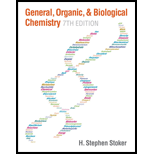
Concept explainers
(a)
Interpretation: The given pair of compounds are epimers or not has to be predicted.
Concept introduction: Epimers are the diastereomers that have a difference in configuration at one chiral center.
(b)
Interpretation: The given pair of compounds are epimers or not has to be predicted.
Concept introduction: Epimers are the diastereomers that have a difference in configuration at one chiral center.
(c)
Interpretation: The given pair of compounds are epimers or not has to be predicted.
Concept introduction: Epimers are the diastereomers that have a difference in configuration at one chiral center.
(d)
Interpretation: The given pair of compounds are epimers or not has to be predicted.
Concept introduction: Epimers are the diastereomers that have a difference in configuration at one chiral center.
Trending nowThis is a popular solution!

Chapter 18 Solutions
GENERAL,ORGANIC,+BIO.CHEM.-MINDTAP
- Which carbon atom is the hemiacetal carbon atom in each of the following structures?arrow_forwardName each of the compounds in Problem 15-106 in the manner described in Section 15-11.arrow_forwardFor each structure in Problem 18-103, identify the configuration at the acetal carbon atom as or .arrow_forward
- Identify the highlighted functional groups in the steroid molecule. - alkane - alkene - benzene (aromatic) - aldehyde - ketone - alkynearrow_forwardH-HSO₂ ndarrow_forwardTell whether each of the following substituents on a steroid is axial or equatorial. (A substituent that is up is on the top face of the molecule as drawn, and a substituent that is down is on the bottom face.) (a) Substituent up at C3 (b) Substituent down at C7 (c) Substituent down at C11arrow_forward
- 15-11 In what way are constitutional isomers different from stereoisomers? In what way are they the same?arrow_forward16-54 Several poisonous plants, including Atropa belladonna, contain the alkaloid atropine. The name “belladonna” (which means “beautiful lady”) probably comes from the fact that Roman women used extracts from this plant to make themselves more attractive. Atropine is widely used by ophthal mologists and optometrists to dilate the pupils for eye examination. Classify the amino group in atropine as primary, secondary, or tertiary. Locate all stereocenters in atropine. Account for the fact that atropine is almost insoluble in water (1 g in 455 mL of cold water) but atropine hydrogen sulfate is very soluble (1 g in 5 mL of cold water). Account for the fact that a dilute aqueous solution of atropine is basic (pH approximately 10.0).arrow_forwardD The following disaccharide contains a(n) (blank]-glycosidic linkage. HO CH₂OH ОН Oa-1,4 OB-1,4 a-1,6 O B-1,6 0 OH Question 6 double bond ssignments/syllabus ester bond ether bond amide bond HO A glycosidic bond between two monosaccharides can also be classified as a(n) [blank). OH OH Melebi OH MacBook Proarrow_forward
- Which of the following is the structure for 3-sec-butyl-1-heptyne? OI Oll O IV ον س سبك xi to y IVarrow_forwardLactose contains what number of anomeric carbons and what number of glycosidic bonds: CH2OH ОН CH2OH ОН OH OH OHarrow_forwardWhich OH groups are in the axial position in B-D-mannopyranose?arrow_forward
 General, Organic, and Biological ChemistryChemistryISBN:9781285853918Author:H. Stephen StokerPublisher:Cengage Learning
General, Organic, and Biological ChemistryChemistryISBN:9781285853918Author:H. Stephen StokerPublisher:Cengage Learning Organic And Biological ChemistryChemistryISBN:9781305081079Author:STOKER, H. Stephen (howard Stephen)Publisher:Cengage Learning,
Organic And Biological ChemistryChemistryISBN:9781305081079Author:STOKER, H. Stephen (howard Stephen)Publisher:Cengage Learning, Chemistry: Principles and PracticeChemistryISBN:9780534420123Author:Daniel L. Reger, Scott R. Goode, David W. Ball, Edward MercerPublisher:Cengage Learning
Chemistry: Principles and PracticeChemistryISBN:9780534420123Author:Daniel L. Reger, Scott R. Goode, David W. Ball, Edward MercerPublisher:Cengage Learning Introduction to General, Organic and BiochemistryChemistryISBN:9781285869759Author:Frederick A. Bettelheim, William H. Brown, Mary K. Campbell, Shawn O. Farrell, Omar TorresPublisher:Cengage Learning
Introduction to General, Organic and BiochemistryChemistryISBN:9781285869759Author:Frederick A. Bettelheim, William H. Brown, Mary K. Campbell, Shawn O. Farrell, Omar TorresPublisher:Cengage Learning




